The Role of Coffee Organizations as Agents of Rural Governance: Evidence from Western Honduras
Abstract
1. Introduction
2. Theoretical Background
2.1. Agents of Rural Governance
2.2. The Systemic Character of Governance
3. Materials and Methods
3.1. Study Setting
3.2. Methodological Strategy
3.3. Data processing and Exploratory Factor Analysis (EFA)
3.4. Confirmatory Factor Analysis (CFA)
3.5. Qualitative Analysis
4. Results and Discussion
4.1. Exploratory Factor Analysis (EFA)
4.2. Confirmatory Factor Analysis (CFA)
4.3. Work with ATLAS.ti
4.4. Implications
5. Conclusions
Author Contributions
Funding
Conflicts of Interest
References
- Gil, J.D.B.; Reidsma, P.; Giller, K.; Todman, L.; Whitmore, A.; van Ittersum, M. Sustainable development goal 2: Improved targets and indicators for agriculture and food security. Ambio 2019, 48, 685–698. [Google Scholar] [CrossRef] [PubMed]
- Arbolino, R.; Carlucci, F.; Cirà, A.; Yigitcanlar, T.; Ioppolo, G. Mitigating Regional Disparities through Microfinancing: An analysis of microcredit as a sustainability tool for territorial development in Italy. Land Use Policy 2018, 70, 281–288. [Google Scholar] [CrossRef]
- Alain, D.J.; Sadoule, E. Toward a Territorial Approach to Rural Development. JDAE 2007, 4, 66–98. [Google Scholar]
- Dale, A.; Vella, K.; Ryan, S.; Broderick, K.; Hill, R.; Potts, R.; Brewer, T. Governing Community-Based Natural Resource Management in Australia: International Implications. Land 2020, 9, 234. [Google Scholar] [CrossRef]
- Leonard, L. Traditional leadership, community participation and mining development in South Africa: The case of Fuleni, Saint Lucia, KwaZulu-Natal. Land Use Policy 2019, 86, 290–298. [Google Scholar] [CrossRef]
- Abel, O.B.; Gor, C.O.; Okuro, S.O.; Omanga, P.A.; Bokelmann, W. The African Indigenous Vegetables Value Chain Governance in Kenya. J. Agric. Econ 2019, 121, 41–52. [Google Scholar] [CrossRef]
- Plata, M. La Emergencia de la Gobernanza para el Desarrollo Sostenible. Ximai 2013, 8, 57–74. [Google Scholar]
- Pappalardo, G.; Sisto, R.; Pecorino, B. Is the Partnership Governance Able to Promote Endogenous Rural Development? Eur. Countrys. 2018, 10, 543–565. [Google Scholar] [CrossRef]
- Bernard, T.; Spielman, D.J. Reaching the Rural Poor through Rural Producer Organizations. A study of agricultural marketing cooperatives in Ethiopia. Food Policy 2009, 34, 60–69. [Google Scholar] [CrossRef]
- Donovan, J.; Poole, N. Changing asset endowments and smallholder participation in higher value markets: Evidence from certified coffee producers in Nicaragua. Food Policy 2014, 44, 1–13. [Google Scholar] [CrossRef]
- Schmit, T.M.; Gómez, M.I. Developing viable farmers markets in rural communities: An investigation of vendor performance using objective and subjective valuations. Food Policy 2011, 36, 119–127. [Google Scholar] [CrossRef]
- Markelova, H.; Meinzen-Dick, R.; Hellin, J.; Dohrn, S. Collective action for smallholder market access. Food Policy 2009, 34, 1–7. [Google Scholar] [CrossRef]
- Gallego, J.R. Economía social y dinámica innovadora en los sistemas territoriales de producción y de innovación. CIRIEC-España 2008, 60, 7–40. [Google Scholar]
- Lan, C.; Peng, L.P. E-Participation, Rural Regime, and Network Governance: A Case of Balien River Conservation. Sustainability 2018, 10, 3908. [Google Scholar] [CrossRef]
- Promme, P.; Kuwornu, J.K.M.; Jourdain, D.; Shivakoti, G.P.; Soni, P. Factors influencing rubber marketing by smallholder farmers in Thailand. Dev. Pract. 2017, 27, 865–879. [Google Scholar] [CrossRef]
- Michalek, J.; Ciaian, P.; Pokrivcak, J. The Impact of Producer Organizations on Farm Performance: The case study of Large farms from Slovakia. Food Policy 2018, 75, 80–92. [Google Scholar] [CrossRef]
- Ramírez, M.; Bernal, P.; Clarke, I.; Hernandez, I. The Role of Social Networks in the Inclusion of Small-Scale Producers in Agri-Food Developing Clusters. Food Policy 2018, 77, 59–70. [Google Scholar] [CrossRef]
- Torfing, J. The Oxford Handbook of Governance; Governance Networks; Oxford University Press: Oxford, UK, 2012; 17p. [Google Scholar]
- Mangnus, E. How inclusive businesses can contribute to local food security. Curr. Opin. Environ. Sustain. 2019, 41, 69–73. [Google Scholar] [CrossRef]
- Herrera, O. Las Capacidades de los Actores para Dirigir la Nueva Gobernanza en el Desarrollo Rural en México. Ph.D. Thesis, Universidad Politécnica de Madrid, Madrid, Spain, 2012; 149p. [Google Scholar]
- Jorquera, B. Gobernanza para el Desarrollo Local. Centro Latinoamericano para el Desarrollo Rural. Doc. Trabajo N 2011, 6, 32. [Google Scholar]
- Aguilar, L.F. El Nuevo Proceso de Gobernar; Friedrich—Naumann Stiftung für die Freiheit: Mexico D.F. Mexico, 2010; 70p. [Google Scholar]
- Ansell, C. Collaborative Platforms as a Governance Strategy. J. Public Adm. Res. Theory 2018, 28, 543–571. [Google Scholar] [CrossRef]
- Saner, S.; Yiu, L.; Nguyen, M. Platform Cooperatives: The Social and Solidarity Economy and the Future of Work. In Proceedings of the UN International Conference, Geneva, Switzerland, 1–2 March 2018; 23p. [Google Scholar]
- Triboulet, P. Cooperativismo, Cadena Alimentaria y Territorios Rurales en Francia. Agric. Fam. en Esp.-Anu. 2015, 2015, 396. [Google Scholar]
- Silva, C.; Salanek, P. Capital social y cooperativismo agropecuario: Una evaluación del funcionamiento de la cooperativa COPACOL/Paraná/Brasil. RCS 2009, 15, 50–67. [Google Scholar]
- Wan, J.; Su, Y.; Zan, H.; Zhao, Y.; Zhang, L.; Dong, X.; Dend, W. Land Functions, Rural Space Governance, and Farmers’ Environmental Perceptions: A Case Study from the Huanjiang Karst Mountain Area, China. Land 2020, 9, 134. [Google Scholar] [CrossRef]
- Freire, C. Economic diversification: A model of structural economic dynamics and endogenous technological change. Struct. Chang. Econ. 2019, 49, 13–28. [Google Scholar] [CrossRef]
- Sathapatyanon, J.; Kuwornu, J.; Shivakoti, G.; Soni, P.; Anal, A.K.; Datta, A. The role of farmer organizations and networks in the rice supply chain in Thailand. J. Agribusiness Dev. Emerg. Econ. 2018, 8, 554–578. [Google Scholar] [CrossRef]
- Martínez, R.; Cruz, H.; Blanco, I.; Salazar, Y. La Innovación social, ¿prácticas para producir autonomía, empoderamiento y nueva institucionalidad? RIS 2019, 77, 126. [Google Scholar] [CrossRef]
- Fischer, H.W.; Chhatre, A. Assets, Livelihoods, and the ‘Profile Approach’ for Analysis of Differentiated Social Vulnerability in the Context of Climate Change. Environ. Plan. 2016, 48, 789–807. [Google Scholar] [CrossRef]
- Kooiman, J. Interactive Governance and Governability: An Introduction. J. Transdiscipl. Environ. Stud. 2008, 7, 1–11. [Google Scholar]
- Stoker, G. Governance as Theory: Five propositions. Int. Soc. Sci. J. 2019, 50, 15–24. [Google Scholar]
- Liu, Y.; Yang, W. Leadership and Governance Tools for Village Sustainable Development in China. Sustainability 2019, 11, 5553. [Google Scholar] [CrossRef]
- Oliveira, E.; Hersperger, A.M. Governance arrangements, funding mechanisms and power configurations in current practices of strategic spatial plan implementation. Land Use Policy 2018, 76, 623–633. [Google Scholar] [CrossRef]
- Moyano, E. Capital Social, Gobernanza y Desarrollo en Áreas Rurales; Instituto de Estudios Sociales Avanzados: Córdoba, Spain, 2009. [Google Scholar]
- Bruckmeier, K. Social-Ecological Transformation. Reconnecting Society and Nature; Pelgrave Macmillan Publishers Ltd.: London, UK, 2016; 423p. [Google Scholar]
- Esparcia, J.; Escribano, J.; Serrano, J.J. Una Aproximación al Enfoque del Capital Social y su Contribución al Estudio de Procesos de Desarrollo Local. Investig. Reg. 2016, 34, 49–71. [Google Scholar]
- Morgan, K. Sustainable regions: Governance, innovation and scale. Eur. Plan. Stud. 2016, 12, 871–889. [Google Scholar] [CrossRef]
- Pike, A.; Rodriguez, P.; Tomamey, J. Local and Regional Development; Routledge Taylor & Francis Group: New York, NY, USA, 2016; 10p. [Google Scholar]
- Bohling, K. Collaborative Governance in the Making: Implementation of a new forest management regime in an old-growth conflict region of British Columbia, Canada. Land Use Policy 2019, 86, 43–53. [Google Scholar]
- Ngutu, M.; Bukashis, S.; Olungah, C.; Kiteme, B.; Kaeser, F.; Haller, T. The Actors, Rules and Regulations Linked to Export Horticulture Production and Access to Land and Water as Common Pool Resources in Laikipia County, Northwest Mount Kenya. Land 2018, 7, 110. [Google Scholar] [CrossRef]
- De los Rios, I.; Rivera, M.; Garcia, C. Redefining rural prosperity through social learning in the cooperative sector: 25 years of experience from Organic Agriculture in Spain. Land Use Policy 2016, 54, 85–94. [Google Scholar] [CrossRef]
- Rodríguez-Albor, G.; Ramos, J.; Sanabria-Landazabal, N. Papel de las Instituciones en los Territorios Subnacionales. Convergencia 2016, 72, 143–169. [Google Scholar] [CrossRef]
- Grashuis, J.; Cook, M.L. A structural Equation Model of Cooperative Member Satisfaction and long-term commitment. IFAMR 2019, 22, 247–263. [Google Scholar] [CrossRef]
- Minten, B.; Dereje, M.; Engida, E.; Kuma, T. Coffee value chains on the move: Evidence in Ethiopia. Food Policy 2019, 83, 370–383. [Google Scholar] [CrossRef]
- Orellana, J.H.; Landaverry, M.M.; Miranda, J.V. Scientific research and its contribution to the development process of western Honduras. ReCyT 2019, 24, 96–118. [Google Scholar]
- Ruerd, R.; Sfez, P.; Ponsioen, T.; Menesses, N. Análisis Integral de la Cadena de Valor del Café en Honduras; Wageningen University: Wageningen, The Netherlands, 2018; 173p. [Google Scholar]
- Chang, R. Análisis de la Cadena de Valor del Sector Cafetalero en Honduras. Rev. Centroam. de Admin. Pública 2017, 72, 148–160. [Google Scholar]
- Tulla, A.F.; Vera, A. Could Social Farming Be a Strategy to Support Food Sovereignty in Europe? Land 2019, 8, 78. [Google Scholar] [CrossRef]
- Moncayo, M.V.M.; Yagüe, B.J.L. Quién incide en la gobernanza local en Nicaragua? El caso de los comités municipales de la soberanía y seguridad alimentaria y nutricional. Cuad. Desarro. Rural. 2016, 13, 11–34. [Google Scholar] [CrossRef]
- Zademach, M.; Hillebrand, S. Alternative Economies and Spaces: New Perspectives for a Sustainable Economy; The Deutche National Bibliothek: Frankfurt am Main, Germany, 2014. [Google Scholar]
- Whittingham, V. Aportes de la teoría y la praxis para la nueva gobernanza. Reforma Democr. CLAD 2005, 33, 1–15. [Google Scholar] [CrossRef]
- Jácome, A.R.; Garrido, A. A Real Option Analysis Applied to the Production of Arabica and Robusta Coffee in Ecuador. SJAR 2017, 15, 76–104. [Google Scholar] [CrossRef]
- Rentkova, K. The Clusters Phenomenon and Sustainable Regional Development. IOP Conf. Ser. 2019, 471, 102039. [Google Scholar] [CrossRef]
- Bacon, C.M.; Méndez, E.; Flores, M.E.; Stuart, D. Are Sustainable Coffee Certifications Enough to Secure Farmer Livelihoods? The millennium development goals and Nicaragua’s fair trade cooperatives. Globalizations 2008, 5, 259–274. [Google Scholar] [CrossRef]
- Ferrero, C.; Mili, S. Desarrollo Rural e Internacionalización mediante Redes de Comercio Justo del Café. Cuad. Desarro. Rural 2013, 10, 267–289. [Google Scholar]
- Döringer, S. Individual agency and socio-spatial change in regional development: Conceptualizing governance entrepreneurship. Geogr. Compass 2020, 21, 1–17. [Google Scholar] [CrossRef]
- Díaz-Puente, J.M.; Gallego-Moreno, F.; Vidueira, P. La estructuración y dinamización social para una mejor gobernanza de las comunidades rurales: Caso de estudio en Cuenca, España. Cuad. Desarro. Rural 2011, 8, 73–101. [Google Scholar]
- Smith, J. Coffee Landscapes: Specialty Coffee, Terroir, and Traceability in Costa Rica. J. Cult. Agric. Coffee 2018, 40, 36–44. [Google Scholar] [CrossRef]
- IICA. Situación del Desarrollo Rural en Honduras; Instituto Interamericano de Ciencia Agropecuaria: Tegucigalpa, Honduras, 2008. [Google Scholar]
- Burgos, P.; Arteaga, N.; Hernández, D.; Ruiz, J. Medición del Desempeño Municipal: Hacia una Gestión Orientada a Resultados; Universidad de los Andes-CEDE: Bogotá, Colombia, 2018; 47p. [Google Scholar]
- Kaufmann, D.; Kraay, A. Governance Matters VI: Aggregate and Individual Governance Indicators; The World Bank Development Research Group: Washintong, DC, USA, 2009; Volume 4978, 105p. [Google Scholar]
- Sanders, A. Assembling the Horticulture Value Chain in Western Honduras. Ph.D. Thesis, Pennsylvania University, Philadelphia, PA, USA, 2019; 209p. [Google Scholar]
- ICO. Trade Statics. Exportable Data from Honduras; International Coffee Organization: London, UK, 2017. [Google Scholar]
- IHCAFE. Datos de Exportación y contribución a la Economía Nacional, Cadena de valor del Café; Instituto Hondureño del Café: Tegucigalpa, Honduras, 2018; 40p. [Google Scholar]
- Sánchez, D.F. Cultivo, Desactivación y Asociatividad: El caso de las Asociaciones Productoras de Café, del Municipio de Barbosa; Universidad de Antioquia # 53: Medellin, Colombia, 2019; 130p. [Google Scholar]
- Civelek, M.E. Essentials of Structural Equation Modeling; University of Nebraska: Lincoln, NE, USA, 2018; 120p. [Google Scholar]
- Roth, E. Análisis Multivariado en la Investigación Psicológica: Modelado Predictivo y Causal con SPSS y AMOS; UCB: La Paz, Bolivia, 2012; 236p. [Google Scholar]
- Byrne, B. Structural Equation Modeling with AMOS; Routledge, Taylor and Francis Group: New York, NY, USA, 2013; 418p. [Google Scholar]
- INE. Estadísticas Instituto Nacional de Estadística, Laboratorio Micro datos Municipal fuente requerida mediante solicitud/2019; INE: Tegucigalpa, Honduras, 2018. [Google Scholar]
- Schmider, E.; Ziegler, M.; Danay, E.; Beyer, L.; Bühner, M. Is It Really Robust?: Reinvestigating the Robustness of ANOVA Against Violations of the Normal Distribution Assumption. Methodology 2010, 6, 147–151. [Google Scholar] [CrossRef]
- Escobedo, M.T.; Hernández, J.; Estebane, V.; Martínez, G. Modelos de Ecuaciones Estructurales: Características, Fases, Construcción, Aplicación y Resultados. Cienc. Trab. 2016, 18, 16–22. [Google Scholar] [CrossRef]
- San Martín, D. Teoría fundamentada y Atlas.ti: Recursos Metodológicos para la investigación educativa. REDIE 2014, 16, 104–122. [Google Scholar]
- Strauss, A.; Corbin, J. Bases de la Investigación Cualitativa: Técnicas y Procedimientos para Desarrollar la Teoría Fundamentada; Universidad de Antioquia: Medellín, Colombia, 2016; 354p. [Google Scholar]
- Giraldo, M. Abordaje de la Investigación Cualitativa a través de la Teoría Fundamentada. Ing. Ind. Tend. 2011, 11, 79–81. [Google Scholar]
- Yin, R.K. Qualitative Research from Start to Finish, 2nd ed.; The Guilford press: London, UK, 2015. [Google Scholar]
- Guetterman, T.C.; Babchuk, W.A.; Howell, M.C.; Stevens, J. Contemporary Approaches to Mixed Methods–Grounded Theory Research: A Field Based Analysis. J. Mix. Methods Res. 2017, 13, 179–195. [Google Scholar] [CrossRef]
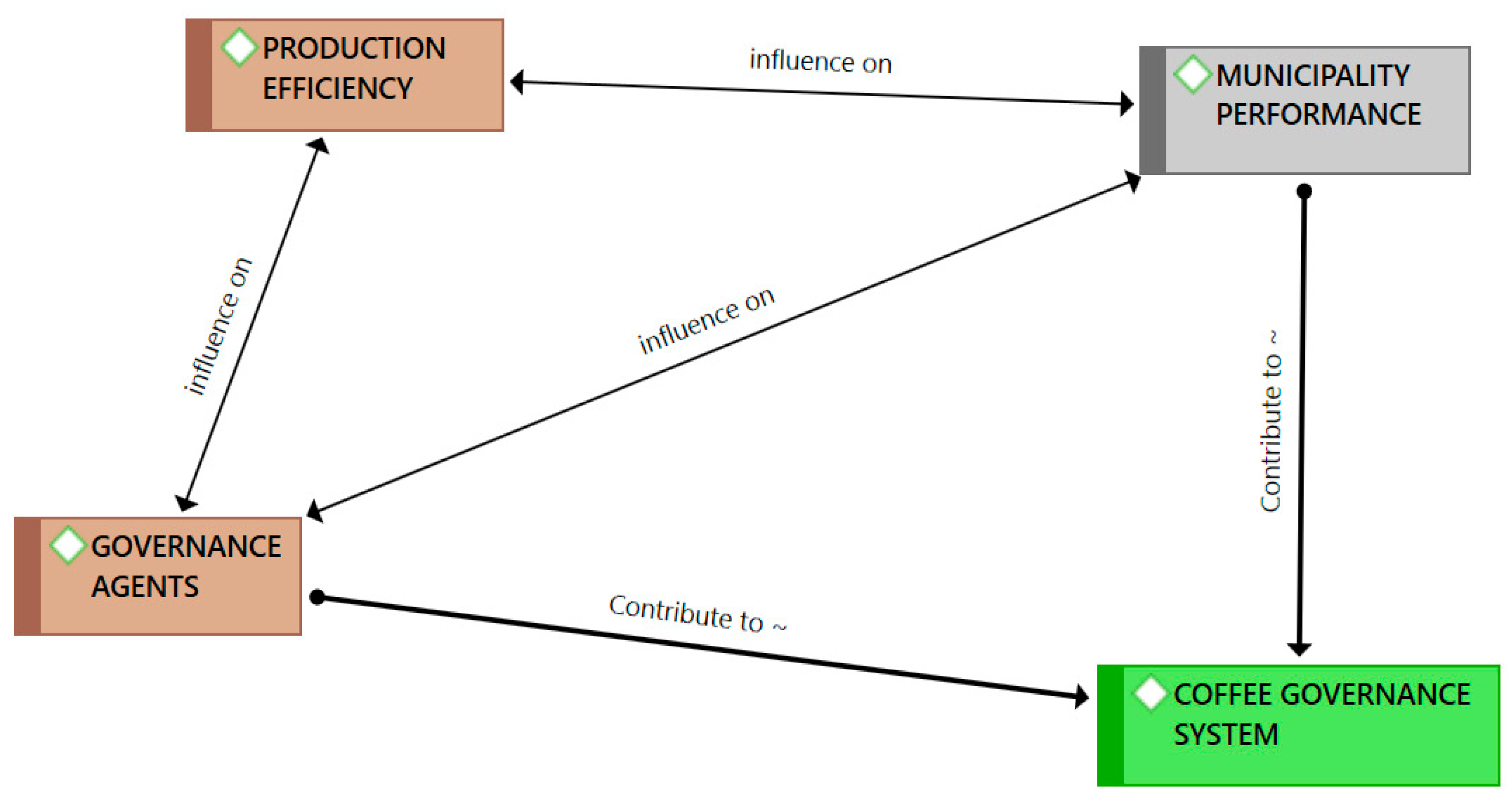
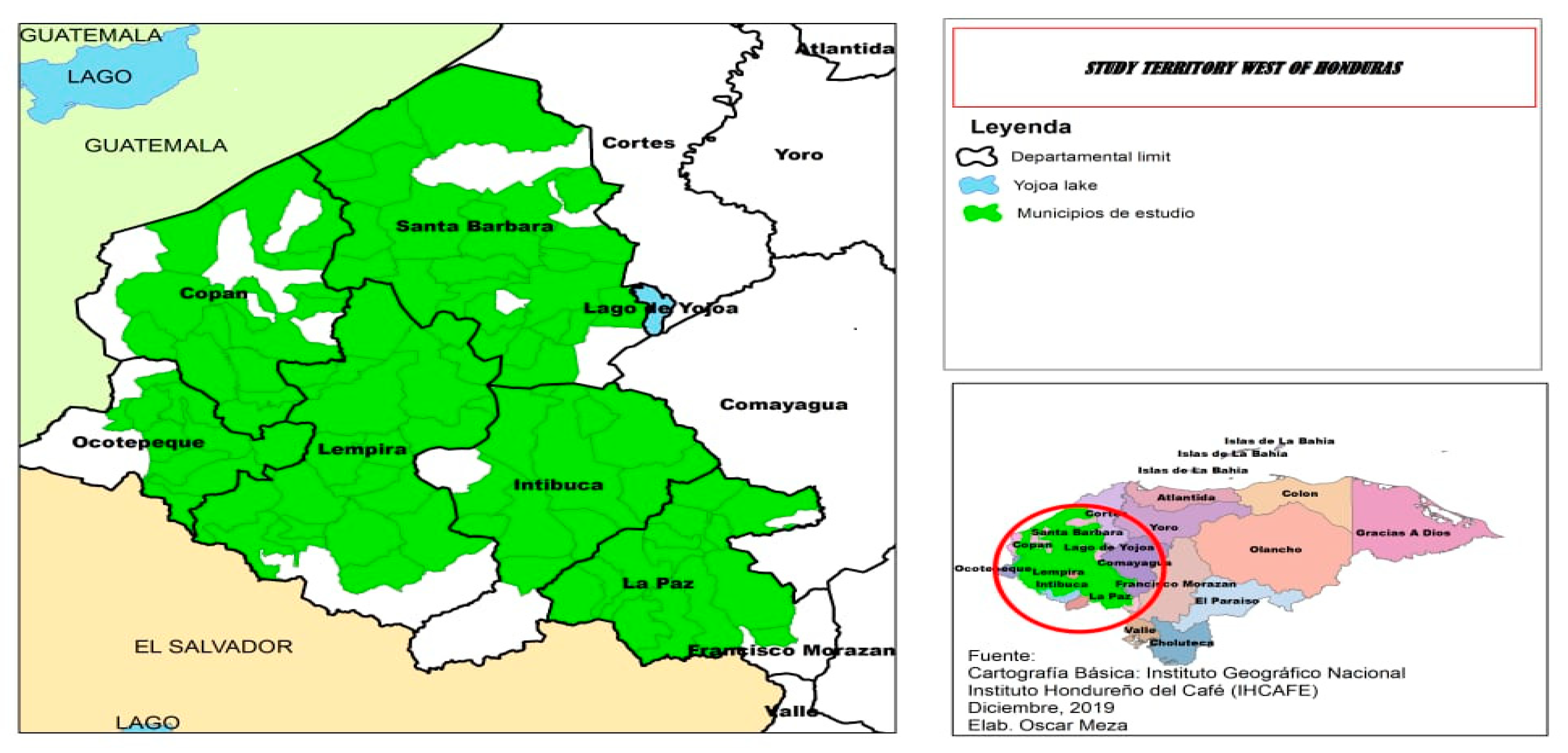
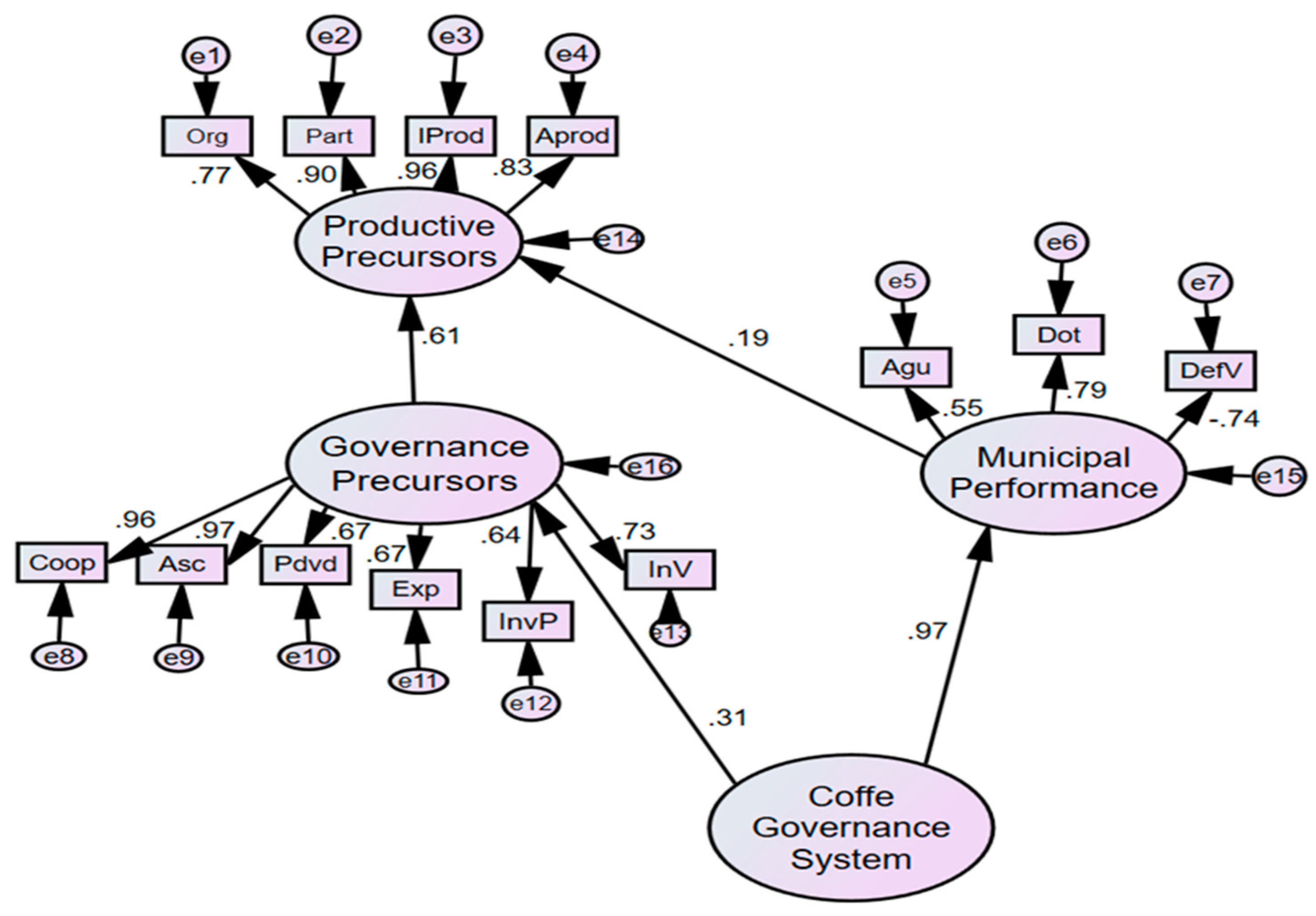
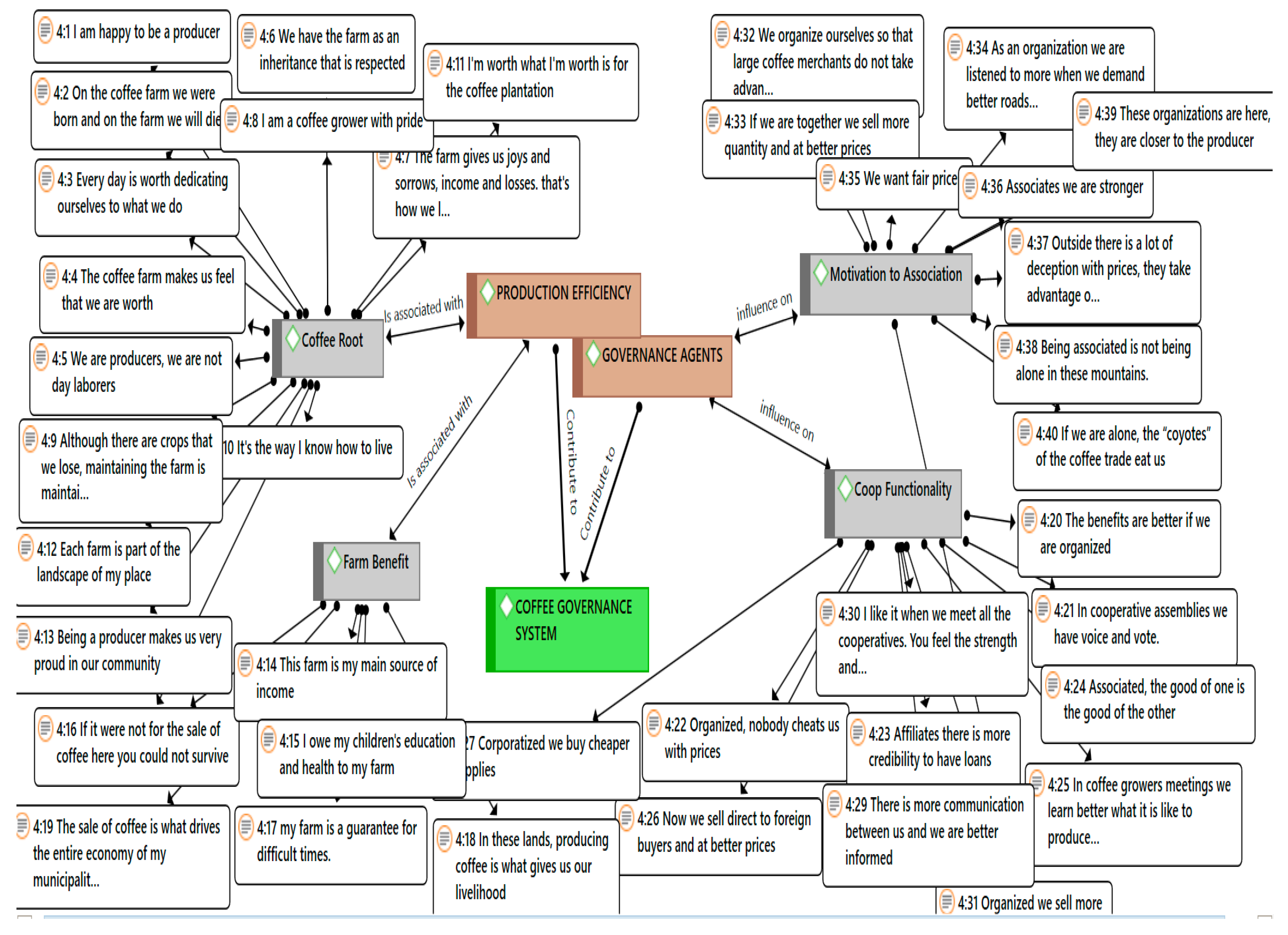
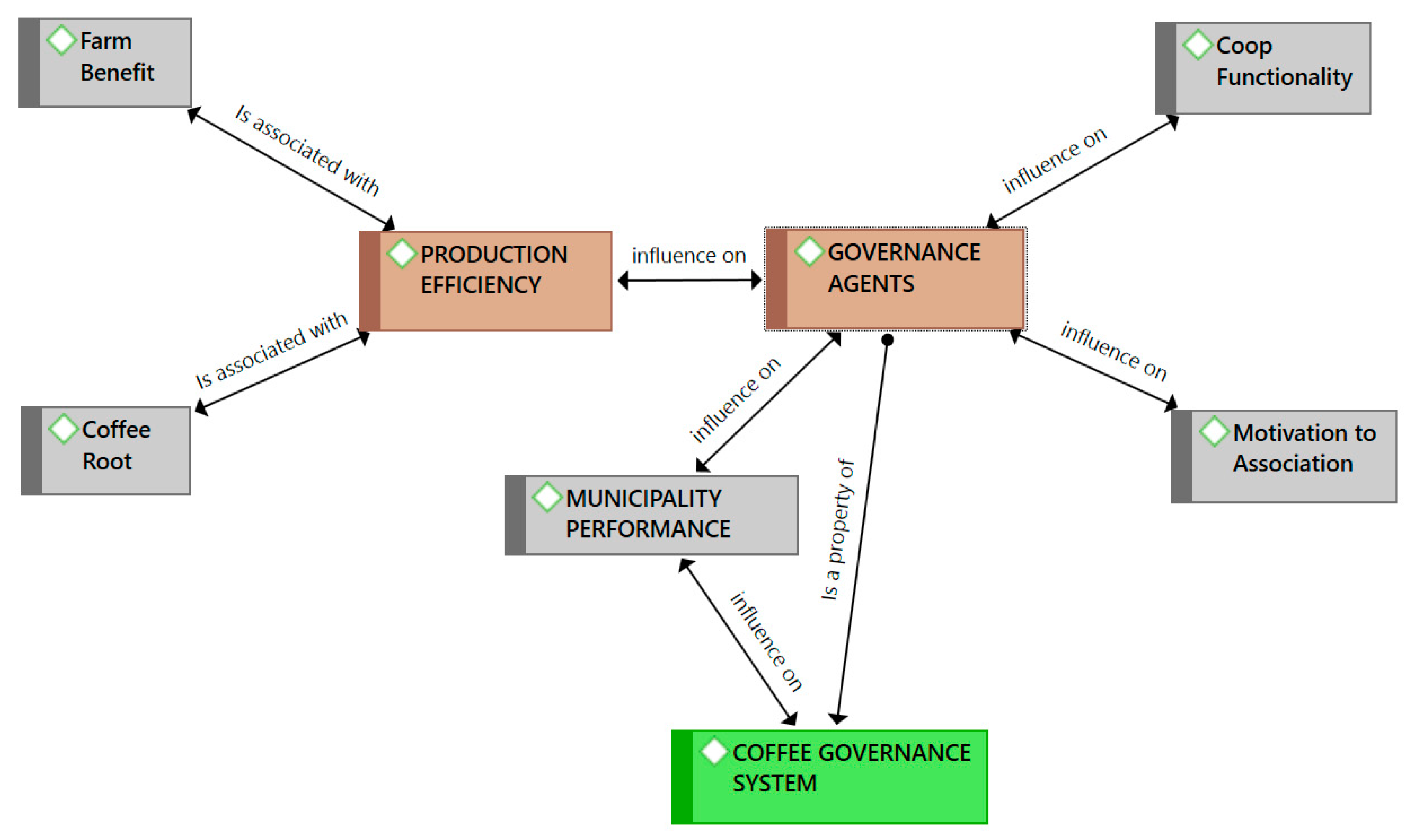
| Constructs | Indicators | Initials | Operative Concept |
|---|---|---|---|
| Governance Agents | Cooperativism | Coop | Index based on the number of existing cooperatives in the municipality |
| Associativity | Asc | Index based on the number of Producers/Cooperative members | |
| Organization | Org | Index based on the number of the existing coffee boards in the municipality | |
| Coffee participation | Part | Index based on the number of producers members of coffee boards | |
| Municipal public investment | Inv P | Percentage dedicated to public investment from the municipal budget | |
| Municipal financial autonomy | Autn | Municipal solvency to invest with own resources | |
| Production efficiency | Productive vocation | VProd | Index based on the number of producers by the municipality |
| Rural municipal population | Prm | Percentage of rural population based on total population | |
| Contribution in municipal production | AProd | Index based on registered harvest volume by the municipality | |
| Productivity index | Pdvd | Index based on production volume per planted area. Coffee quintal/block | |
| Exportable index | Exp | Percentage of production that can be exported | |
| Municipality performance | Drinking water coverage index | Agu | Percentage coverage of drinking water networks in the municipality |
| Electric coverage index | Elct | Percentage coverage of electrical networks in the municipality | |
| Road investment index or rural roads | InvV | Monetary volume of investment roads by the municipality | |
| Housing deficit | DefV | Homelessness or deficit index in rural space | |
| Health-education endowment | Dot | Proportion of schools and health centers by the municipality |
| Variables | Components | Components | |||||
|---|---|---|---|---|---|---|---|
| 1 | 2 | 3 | 1 | 2 | 3 | ||
| Productivity (Pdvd) | 0.907 | - | - | Productive vocation (Vprod) | - | 0.888 | - |
| Cooperativism (coop) | 0.812 | 0.389 | - | Organization (Org) | 0.318 | 0.734 | |
| Municipal Autonomy (Autn) | 0.799 | - | - | ||||
| Associativity (Asc) | 0.790 | 0.436 | - | Contribution in municipal Production (AProd) | 0.487 | 0.711 | |
| Municipal Public Investment (inv p) | 0.678 | - | - | Housing déficit (DefV) | - | - | −0.856 |
| Roads Investment (InvV) | 0.645 | 0.487 | - | Electricity coverage (Elct) | - | - | 0.810 |
| Export (Exp) | 0.635 | 0.383 | 0.335 | Water network coverage (Agu) | 0.308 | - | 0.729 |
| Coffee Participation (part) | - | 0.905 | - | Health-Education Endowment (Dot) | - | - | 0.703 |
| Components (Constructs) | Total Variance | ||
|---|---|---|---|
| Sums of Charges Squared by Rotation | |||
| Total | % Variety | % Accumulated | |
| 1. Governance Agents | 4.591 | 28.69 | 28.69 |
| 2. Production Efficiency | 4.185 | 26.16 | 54.85 |
| 3. Municipality performance | 2.80 | 17.51 | 72.36 |
| Adjustment Index | Initials | Expected | Results |
|---|---|---|---|
| Chi2 | >0.05 | 122.520 | |
| Discrepancy between Chi2 and degrees of freedom | CMIN/DF | ≤5 | 2.112 |
| Comparative Adjustment Index | CFI | 0.90–1 | 0.935 |
| Non-Standard Adjustment Index | TLI | 0.90–1 | 0.913 |
| Normalized Adjustment Index | NFI | 0.90–1 | 0.887 |
| Root mean square error of approximation | RMSEA | ≤0.08 | 0.111 |
Publisher’s Note: MDPI stays neutral with regard to jurisdictional claims in published maps and institutional affiliations. |
© 2020 by the authors. Licensee MDPI, Basel, Switzerland. This article is an open access article distributed under the terms and conditions of the Creative Commons Attribution (CC BY) license (http://creativecommons.org/licenses/by/4.0/).
Share and Cite
Palma, O.M.; Díaz-Puente, J.M.; Yagüe, J.L. The Role of Coffee Organizations as Agents of Rural Governance: Evidence from Western Honduras. Land 2020, 9, 431. https://doi.org/10.3390/land9110431
Palma OM, Díaz-Puente JM, Yagüe JL. The Role of Coffee Organizations as Agents of Rural Governance: Evidence from Western Honduras. Land. 2020; 9(11):431. https://doi.org/10.3390/land9110431
Chicago/Turabian StylePalma, Oscar Meza, José M. Díaz-Puente, and José L. Yagüe. 2020. "The Role of Coffee Organizations as Agents of Rural Governance: Evidence from Western Honduras" Land 9, no. 11: 431. https://doi.org/10.3390/land9110431
APA StylePalma, O. M., Díaz-Puente, J. M., & Yagüe, J. L. (2020). The Role of Coffee Organizations as Agents of Rural Governance: Evidence from Western Honduras. Land, 9(11), 431. https://doi.org/10.3390/land9110431






